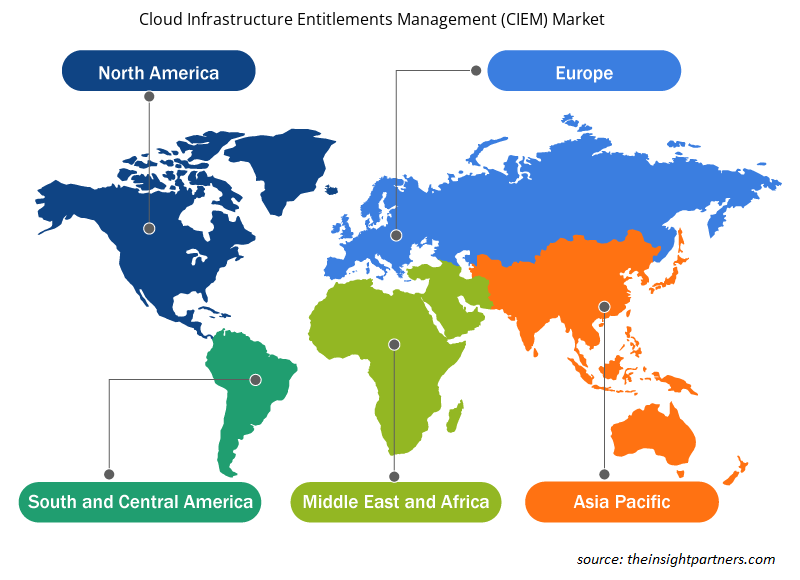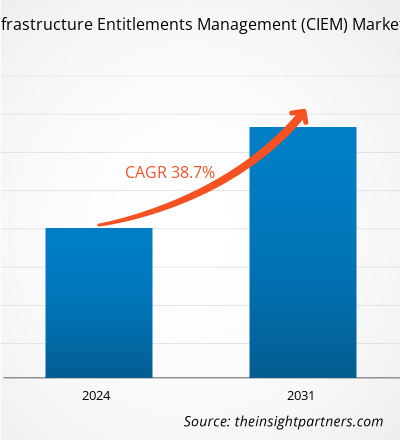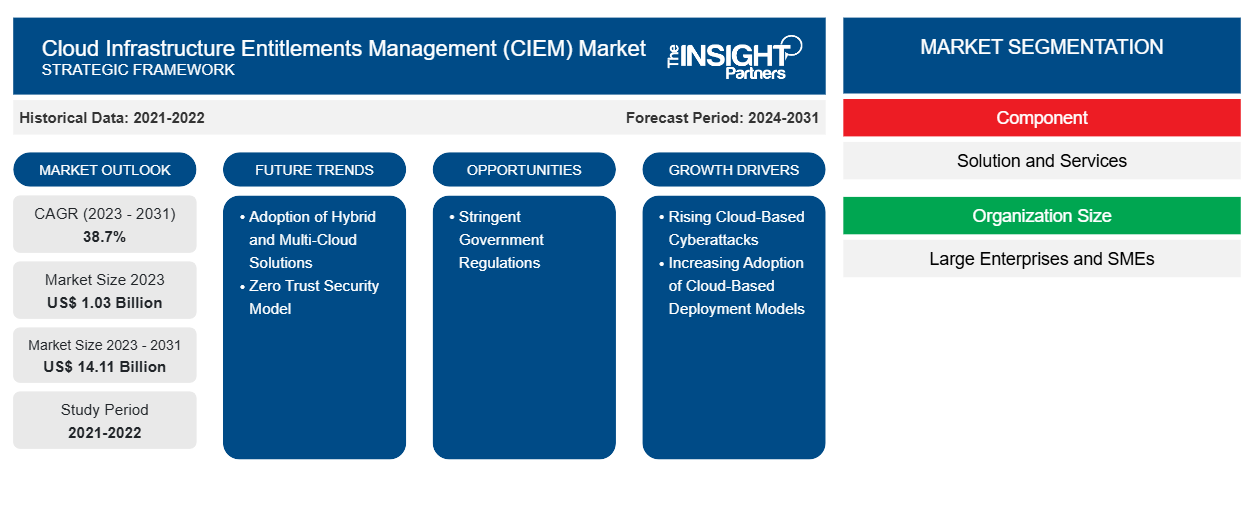Si prevede che la dimensione del mercato della gestione dei diritti delle infrastrutture cloud (CIEM) raggiungerà i 14,11 miliardi di dollari entro il 2031, rispetto agli 1,03 miliardi di dollari del 2023. Si stima che il mercato registrerà un CAGR del 38,7% nel periodo 2023-2031. È probabile che introducano nuove tendenze sul mercato.
Analisi di mercato della gestione dei diritti delle infrastrutture cloud (CIEM)
La necessità di cloud infrastructure entitlements management (CIEM) è guidata dalla crescente necessità delle aziende di migliorare la sicurezza del cloud. Il crescente utilizzo di soluzioni e servizi cloud, progetti di trasformazione digitale e un numero crescente di attacchi informatici basati su cloud sono alcuni dei fattori che guidano il mercato. La pandemia di COVID-19 ha costretto molte aziende a passare dall'on-premise al cloud computing, il che ha portato all'espansione del mercato di cloud infrastructure entitlements management (CIEM) . Il rapporto include prospettive di crescita dovute alle attuali tendenze del mercato di cloud infrastructure entitlements management (CIEM) e al loro impatto prevedibile durante il periodo di previsione.
Panoramica del mercato della gestione dei diritti delle infrastrutture cloud (CIEM)
Cloud infrastructure entitlements management (CIEM), o cloud entitlements management solutions o cloud permissions management solutions, è una soluzione di sicurezza cloud che mitiga il rischio di violazioni dei dati in ambienti cloud pubblici. Le soluzioni di cloud infrastructure entitlements management sono sviluppate specificamente per gestire i privilegi in modo rigoroso e coerente in ambienti complessi e dinamici. Le soluzioni di cloud infrastructure entitlements management monitorano costantemente i permessi e l'attività delle entità per prevenire diritti eccessivi. Le funzioni principali di CIEM sono visibilità dei diritti, permessi di dimensionamento, analisi avanzate e conformità.
Personalizza questo report in base alle tue esigenze
Riceverai la personalizzazione gratuita di qualsiasi report, comprese parti di questo report, o analisi a livello nazionale, pacchetto dati Excel, oltre a usufruire di grandi offerte e sconti per start-up e università
- Scopri le principali tendenze di mercato in questo rapporto.Questo campione GRATUITO includerà analisi di dati che spaziano dalle tendenze di mercato alle stime e alle previsioni.
Driver e opportunità di mercato per la gestione dei diritti delle infrastrutture cloud (CIEM)
Aumento degli attacchi informatici basati sul cloud
L'adozione del cloud computing ha guadagnato una trazione enorme negli ultimi anni con attori chiave come Amazon, Google e Microsoft. Il cloud computing ha modificato il modo in cui le aziende utilizzano, archiviano e condividono dati e informazioni. Tuttavia, tutto ciò che opera digitalmente diventerà inevitabilmente un bersaglio per gli attori informatici. Lo spostamento delle organizzazioni verso il cloud computing ha creato nuove strade per i criminali informatici per sfruttare vulnerabilità, compromettere dati e creare scompiglio in organizzazioni di tutte le dimensioni. I dati archiviati nell'ambiente cloud sono più vulnerabili dei dati sui server in loco. Configurazione errata, account utente compromessi, vulnerabilità API, attività interne dannose e altro sono tra le principali cause di attacchi informatici al cloud computing. Negli ultimi anni, il numero di attacchi alle piattaforme cloud è aumentato rapidamente. Gli attacchi informatici basati su cloud hanno rappresentato il 20% di tutti gli attacchi informatici nel 2020, rendendo le piattaforme basate su cloud il terzo ambiente informatico più preso di mira. A gennaio 2020, Microsoft ha annunciato che uno dei suoi database cloud è stato violato a dicembre 2019, il che ha comportato l'esposizione di 250 milioni di voci, tra cui indirizzi e-mail, indirizzi IP e dettagli dei casi di supporto. Cloud infrastructure entitlement management (CIEM) è una soluzione di sicurezza cloud automatizzata che mitiga il rischio di violazioni dei dati negli ambienti cloud pubblici implementando la sicurezza cloud. Pertanto, l'aumento degli attacchi informatici basati su cloud spinge la crescita del mercato della gestione dei diritti delle infrastrutture cloud.
Regolamentazioni governative severe
Diverse normative governative e di settore richiedono alle aziende di aderire a rigidi controlli di sicurezza. In uno scenario del genere, la gestione dei diritti dell'infrastruttura cloud è un aspetto cruciale della strategia di sicurezza informatica di un'organizzazione. In settori come sanità, finanza e governo che gestiscono dati sensibili, le organizzazioni di tutte le dimensioni devono rispettare normative complesse come GDPR, HIPAA, PCI-DSS e SOX per proteggere i dati sensibili di consumatori e aziende. La mancata conformità a queste normative può comportare pesanti multe e danni alla reputazione dell'organizzazione. Ad esempio, il Regolamento generale sulla protezione dei dati (GDPR), istituito nel 2018, impone multe fino a 21,68 milioni di dollari (20 milioni di euro) o il 4% del fatturato annuo globale dell'azienda, a seconda di quale sia più alto. Allo stesso modo, le multe per violazioni dell'Health Insurance Portability and Accountability Act (HIPAA) possono arrivare fino a 1,5 milioni di dollari per violazione. La Securities and Exchange Commission (SEC) impone multe da decine di migliaia a milioni di dollari. Le multe per violazioni dell'Occupational Safety and Health Administration (OSHA) possono arrivare fino a 134.937 $ USA per violazione, mentre le violazioni del Foreign Corrupt Practices Act (FCPA) possono richiedere una multa di un totale di 25 milioni di $ USA o più. L'Environmental Protection Agency (EPA) può comminare multe fino a 50.000 $ USA al giorno per violazione. Le aziende in tutto il mondo hanno dovuto affrontare multe enormi a causa della violazione di queste normative. Ad esempio, secondo un sondaggio condotto da Kaspersky su 500 organizzazioni in tutto il mondo, la perdita media di un'azienda a causa di una violazione è di 551.000 $ USA, di cui la perdita media delle piccole e medie imprese a causa di una violazione è di 38.000 $ USA. Pertanto, le organizzazioni sono tenute a implementare soluzioni di gestione dei diritti dell'infrastruttura cloud per conformarsi alle severe normative governative come PCI DSS, CCPA, HIPAA, SOX e GDPR, offrendo opportunità redditizie per la crescita del mercato.
Analisi della segmentazione del rapporto di mercato sulla gestione dei diritti delle infrastrutture cloud (CIEM)
I segmenti chiave che hanno contribuito alla derivazione dell'analisi di mercato della gestione dei diritti delle infrastrutture cloud (CIEM) sono i componenti, le dimensioni dell'organizzazione, l'utente finale e l'area geografica.
- In base al componente, il mercato è diviso in soluzioni e servizi. Il segmento delle soluzioni ha dominato il mercato nel 2023.
- In termini di dimensioni dell'organizzazione, il mercato è diviso in grandi imprese e PMI. Il segmento delle grandi imprese ha dominato il mercato nel 2023.
- In base all'utente finale, il mercato è segmentato in IT e telecomunicazioni, sanità, produzione, BFSI, vendita al dettaglio ed e-commerce e altri. Il segmento IT e telecomunicazioni ha detenuto una quota maggiore del mercato nel 2023.
Analisi della quota di mercato di Cloud Infrastructure Entitlements Management (CIEM) per area geografica
Il mercato della gestione dei diritti delle infrastrutture cloud (CIEM) è suddiviso in cinque regioni principali: Nord America, Europa, Asia Pacifico (APAC), Medio Oriente e Africa (MEA) e Sud e Centro America. Il Nord America ha dominato il mercato nel 2023, seguito da Europa e APAC.
Il Nord America è una delle regioni in più rapida crescita in termini sia di innovazioni tecnologiche che di adozione di tecnologie avanzate. L'infrastruttura IT in espansione della regione e il passaggio accelerato ai servizi cloud richiedono misure di sicurezza avanzate. Nel 2023, il Nord America deteneva la quota di mercato più grande nel mercato della gestione dei diritti delle infrastrutture cloud (CIEM). La crescente prevalenza dei servizi mobili e il crescente numero di violazioni della sicurezza legate all'abuso di identità e accesso privilegiato contribuiscono all'adozione di soluzioni CIEM nella regione. Le soluzioni CIEM in Nord America mirano a gestire identità e privilegi negli ambienti cloud. Mirano a comprendere i diritti di accesso esistenti negli ambienti cloud e multi-cloud e quindi a identificare e mitigare il rischio derivante dai diritti.
Approfondimenti regionali sul mercato della gestione dei diritti delle infrastrutture cloud (CIEM)
Le tendenze regionali e i fattori che influenzano il mercato Cloud Infrastructure Entitlements Management (CIEM) durante il periodo di previsione sono stati ampiamente spiegati dagli analisti di Insight Partners. Questa sezione discute anche i segmenti di mercato Cloud Infrastructure Entitlements Management (CIEM) e la geografia in Nord America, Europa, Asia Pacifico, Medio Oriente e Africa e Sud e Centro America.

- Ottieni i dati specifici regionali per il mercato Cloud Infrastructure Entitlements Management (CIEM)
Ambito del rapporto di mercato sulla gestione dei diritti delle infrastrutture cloud (CIEM)
| Attributo del report | Dettagli |
|---|---|
| Dimensioni del mercato nel 2023 | 1,03 miliardi di dollari USA |
| Dimensioni del mercato entro il 2031 | 14,11 miliardi di dollari USA |
| CAGR globale (2023-2031) | 38,7% |
| Dati storici | 2021-2022 |
| Periodo di previsione | 2024-2031 |
| Segmenti coperti | Per componente
|
| Regioni e Paesi coperti | America del Nord
|
| Leader di mercato e profili aziendali chiave |
|
Densità degli attori del mercato della gestione dei diritti delle infrastrutture cloud (CIEM): comprendere il suo impatto sulle dinamiche aziendali
Il mercato Cloud Infrastructure Entitlements Management (CIEM) sta crescendo rapidamente, spinto dalla crescente domanda degli utenti finali dovuta a fattori quali l'evoluzione delle preferenze dei consumatori, i progressi tecnologici e una maggiore consapevolezza dei vantaggi del prodotto. Con l'aumento della domanda, le aziende stanno ampliando le loro offerte, innovando per soddisfare le esigenze dei consumatori e capitalizzando sulle tendenze emergenti, il che alimenta ulteriormente la crescita del mercato.
La densità degli operatori di mercato si riferisce alla distribuzione di aziende o società che operano in un particolare mercato o settore. Indica quanti concorrenti (operatori di mercato) sono presenti in un dato spazio di mercato in relazione alle sue dimensioni o al valore di mercato totale.
Le principali aziende che operano nel mercato della gestione dei diritti delle infrastrutture cloud (CIEM) sono:
- Microsoft
- Reti di Palo Alto
- Società controllata da Check Point Software Technologies Ltd.
- Società per azioni CrowdStrike Holdings Inc.
- Software di CyberArk Ltd
- Azienda
Disclaimer : le aziende elencate sopra non sono classificate secondo un ordine particolare.

- Ottieni la panoramica dei principali attori del mercato Cloud Infrastructure Entitlements Management (CIEM)
Notizie di mercato e sviluppi recenti sulla gestione dei diritti delle infrastrutture cloud (CIEM)
Il mercato della gestione dei diritti delle infrastrutture cloud (CIEM) viene valutato raccogliendo dati qualitativi e quantitativi dopo la ricerca primaria e secondaria, che include importanti pubblicazioni aziendali, dati associativi e database. Di seguito sono elencati alcuni degli sviluppi nel mercato della gestione dei diritti delle infrastrutture cloud (CIEM):
- Lacework ha annunciato il lancio della funzionalità di gestione dei diritti cloud per la sua piattaforma di protezione delle applicazioni cloud-native (CNAPP). Con questo nuovo set di funzionalità, le organizzazioni possono applicare il principio del privilegio minimo quando creano, distribuiscono, utilizzano e gestiscono servizi di infrastruttura cloud. (Fonte: Lacework, comunicato stampa, giugno 2023)
- Tenable ha annunciato l'acquisizione di Ermetic, Ltd. Con questa acquisizione, Tenable ed Ermetic aiuteranno le organizzazioni ad affrontare alcune delle difficili sfide della sicurezza informatica. (Fonte: Tenable, comunicato stampa, ottobre 2023)
- Uptycs ha annunciato il lancio di funzionalità di cloud infrastructure entitlement management (CIEM) che rafforzano la sua offerta di cloud security posture management (CSPM). Inoltre, Uptycs ha annunciato il supporto CSPM per Google Cloud Platform (GCP) e Microsoft Azure, nonché la copertura di conformità PCI. Queste nuove funzionalità forniscono ai team di sicurezza e governance, rischio e conformità un monitoraggio continuo di servizi cloud, identità e entitlement al fine di ridurre il rischio di attacchi al cloud. (Fonte: Uptycs, comunicato stampa, maggio 2022)
Copertura e risultati del rapporto di mercato sulla gestione dei diritti delle infrastrutture cloud (CIEM)
"Dimensioni e previsioni del mercato Cloud Infrastructure Entitlements Management (CIEM) (2021-2031)" fornisce un'analisi dettagliata del mercato che copre le aree menzionate di seguito:
- Dimensioni e previsioni del mercato della gestione dei diritti delle infrastrutture cloud (CIEM) a livello globale, regionale e nazionale per tutti i segmenti di mercato chiave coperti dall'ambito
- Tendenze del mercato della gestione dei diritti delle infrastrutture cloud (CIEM) e dinamiche di mercato come driver, limitazioni e opportunità chiave
- Analisi PEST e SWOT dettagliate
- Analisi di mercato della gestione dei diritti delle infrastrutture cloud (CIEM) che copre le principali tendenze del mercato, il quadro globale e regionale, i principali attori, le normative e i recenti sviluppi del mercato
- Analisi del panorama industriale e della concorrenza che copre la concentrazione del mercato, l'analisi della mappa di calore, i principali attori e gli sviluppi recenti per il mercato della gestione dei diritti delle infrastrutture cloud (CIEM)
- Profili aziendali dettagliati
- Analisi storica (2 anni), anno base, previsione (7 anni) con CAGR
- Analisi PEST e SWOT
- Valore/volume delle dimensioni del mercato - Globale, Regionale, Nazionale
- Industria e panorama competitivo
- Set di dati Excel
Report recenti
Testimonianze
Motivo dell'acquisto
- Processo decisionale informato
- Comprensione delle dinamiche di mercato
- Analisi competitiva
- Analisi dei clienti
- Previsioni di mercato
- Mitigazione del rischio
- Pianificazione strategica
- Giustificazione degli investimenti
- Identificazione dei mercati emergenti
- Miglioramento delle strategie di marketing
- Aumento dell'efficienza operativa
- Allineamento alle tendenze normative























 Ottieni un campione gratuito per - Mercato della gestione dei diritti delle infrastrutture cloud (CIEM)
Ottieni un campione gratuito per - Mercato della gestione dei diritti delle infrastrutture cloud (CIEM)